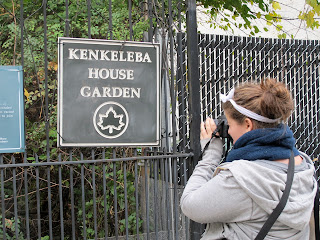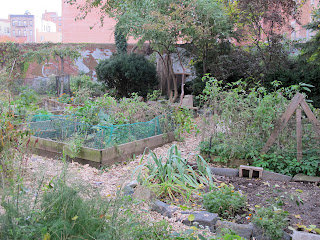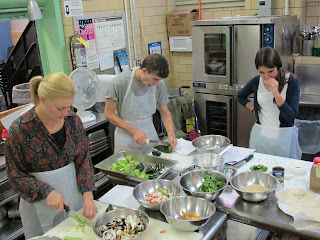Experiences, Resources and Musings from the Bard High School Food Systems and Politics Class. Manhattan, NY, USA, Planet Earth
Tuesday, December 13, 2011
Garden Design
Monday, December 5, 2011
Putting the Garden Away for the Winter
We also planted a variety of daffodil bulbs, since bulbs can grow under the soil during winter and won't perish. In order to keep pests and rodents from digging up the bulbs and eating them, as they are wont to do, we used rat poison. Just kidding! We did not use rat poison! Instead, we used cayenne pepper, which is a deterrent to pests, and is not harmful to people, unless it gets into their eyes (the latter possibility did become something of a problem.)
Here's a passage on what's going on in your garden during the winter, taken from our handout on winterization.
While it appears as if all activity in the garden has stopped, there's a lot going on under the soil until it freezes. Newly transplanted trees and shrubs, divisions of perennials, and hardy bulbs are all growing roots, drawing on soil nutrients and moisture around them. earthworms and various microbes in the soil are still processing the organic material they're finding. Most likely, the organic mulch you spread to protect the soil has substantially decomposed. It's important to spread new mulch now--a thicker winter layer--to protect plants and soil over the winter months. The idea is not to much to keep the soil warm as it is to keep the temperature even. Once the soil is frozen, mulch keeps it frozen. Snow both protects and endangers plants.
Hopefully we'll get some pictures of our winterization up soon!
Wednesday, November 30, 2011
Cooking Class # 2 :D
These are the things we included in our salad:
Large bunch of kale
2 red peppers
2 cucumbers
3 carrots
handful of raw sunflower seed
handful of raw walnut
1 or 2 lemons
olive oil
balsamic vinegar
salt
2 cups of cooked quinoa (cooked in water)
handful of raisins

Before mixing all this together, we made sure to massage the kale for a good 10-15 minutes, which helps break down the kale (we noticed that the color changed a bit after we were done massaging and the smell became much stronger)

Isa brought in a bone broth which helps support the immune system and our bones/joints. When the cap was taken of the broth a thin layer of fat was resting on top. It is recommended to leave this fat there because it helps preserve the broth.We heated the broth and those who wanted had the choice to add mushroom, chives and tofu.


Thursday, November 24, 2011
Herbs with Isa
Wednesday, November 16, 2011
Community Gardens
Sunday, October 16, 2011
Lettuce Seed Saving



Last Thursday's class, we learned about the process seed saving by collecting seeds from our own lettuce plants. Lettuce was a good plant to start with, in part because we had so much of it, but also because lettuce seeds are self-pollenated, so they are unlikely to cross-pollenate with other seeds. As you can see, lettuce seeds are extremely small, but what they lose in size they make up for in abundance; each flower contains at least a dozen seeds. Here are a few tips about saving lettuce seed:
1) Even if you only need a few seeds, choose and mark more than one plant to collect seeds from. This encourages biodiversity, since different plants may have slightly different seeds; one may be more pest resistant, for example, and another may be better able to tolerate more water. Make sure you mark the plants you will take seed from. This can be done with something as simple as a tag or a label stuck into the soil next to the plant.
2) The seeds of lettuce plants are contained in small flowers that form late in the plant's life, when it is "bolting," or going to seed. These are the stages of a bolting lettuce plant:
a) A stalk will emerge from the top of the plant.
b) This stalk will grow and flower.
c) The flower will self-pollenate and turn into a small puff, not unlike a smaller version of a dandelion.
Many gardeners regard bolting lettuce as a problem, but it is merely a stage in the lettuce's life cycle. As long as you harvest the leaves before the lettuce starts to bolt, those little flowers will actually be to your benefit, as they produce the seeds that you can use to have lettuce forever.
3) Once the seed heads have dried a bit, trim and collect the stalks and harvest the seeds. With lettuce, the easiest method is to just shake them free into a sheet or basket and then collect them into a seed packet. If you'd like to be more thorough, another method is to pull the flowers out of each seed with your fingertips.
4) Next, dry your newly harvested seed for a day or two. There are two possible ways of doing this. If it is sunny, you can just leave the seeds out to sun dry for a day or two, covering them over at night. If the weather is more dark and damp, a good strategy is to hang your stalks in a paper bag inside a warm, dry cupboard.
5) Label your seeds! Although a seemingly obvious step, labeling is extremely important. Write the date, name of variety and germination rate (see below). It's a good idea to do a germination test here, to see how viable your seeds are.
GERMINATION TEST
For this simple test, you will need paper towels, sealable plastic bags, a marker, and a notebook.
1) Moisten a paper towel, so that it is damp but not soggy. A misting spray bottle is a good tool to use.
2) Choose at least ten seeds that you think represent your seed population. For example, we had black, white and gold seeds, so we made sure to include all three in our test. The more seeds you use, the more statistically accurate your results will be.
3) Place your selected seeds on one half of the damp paper towel, and fold it in two over the seeds.
4) Place the towel with the seeds into a partially closed plastic bag. Label the bag. Write the variety of seed, date, and number of seeds on the bag and in your notebook.
5) Keep the bag in a warm, dark place such as a kitchen cupboard. Check the seeds on a daily basis. Note seed progress in your notebook. Make sure to keep the paper towel evenly moist.
6) After several days (the exact time depends on the variety), your seeds should begin to germinate. If a seed looks moldy or rotten, make a note and discard it. If a seed begins to grow, make a note and discard it. Keep notes on how many good and bad seeds you have discarded.
7) After around two weeks, or when all of the seeds have been discarded, tally up what percentage of your seeds were good and bad. If you have a germination rate 50% or higher (meaning that at least 50% of the seeds were good), then go ahead and plant them. Keep in mind that you will only get as many seeds as the germination rate dictates; for example, if you have a 70% germination rate and you plant ten seeds, you will probably only get seven plants. If your germination rate is less than 50%, it's best to buy fresh seed.
Tuesday, October 11, 2011
Menu and Recipes from our Mexican Feast
A Historic First- Cooking in BHSEC's Cafeteria Kitchen
Many, many thanks to our spectacular school cook Evelyn for helping out and teaching us a few new tricks!
mexican feast!!
Seed Saving//GMO's
Thursday, September 29, 2011
Seed Starting!
Our first few days of gardening were spent cleaning out the beds and prepping them for winter crops
We used this opportunity to learn and revisit basic gardening principals of pruning, weeding, seed saving, amending soil and transplanting.























